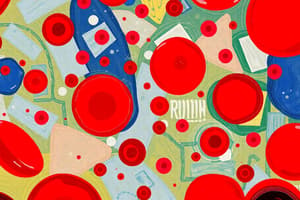Podcast
Questions and Answers
A healthy adult male has an average of 5-5.5 million RBCs per mm³ of ______.
A healthy adult male has an average of 5-5.5 million RBCs per mm³ of ______.
blood
Erythrocytes are formed in the red bone ______.
Erythrocytes are formed in the red bone ______.
marrow
Leucocytes are also known as white blood ______.
Leucocytes are also known as white blood ______.
cells
Basophils are the least abundant type of white blood cells, comprising about ______ of the total WBC count.
Basophils are the least abundant type of white blood cells, comprising about ______ of the total WBC count.
Old or damaged RBCs are destroyed in the ______, which is considered the graveyard of RBCs.
Old or damaged RBCs are destroyed in the ______, which is considered the graveyard of RBCs.
Flashcards are hidden until you start studying
Study Notes
Formed Elements in Blood
- Erythrocytes, leukocytes, and platelets are collectively called formed elements.
- Erythrocytes (RBCs) are the most abundant blood cells.
- A healthy adult male has an average of 5-5.5 million RBCs per mm³ of blood.
- RBCs are formed in the red bone marrow.
- RBCs are biconcave and lack a nucleus.
- They contain hemoglobin, a red-colored, iron-containing protein that transports respiratory gases.
- The average lifespan of an RBC is 120 days.
- Old or damaged RBCs are destroyed in the spleen, which is considered the graveyard of RBCs.
- A healthy individual has 12-16 gms of hemoglobin in every 100 ml of blood.
Leukocytes (White Blood Cells)
- Leukocytes are also known as white blood cells (WBCs).
- They are colorless due to the lack of hemoglobin.
- They are nucleated cells.
- The average number of WBCs per mm³ of blood is 6000-8000.
- WBCs have two main categories: Granulocytes and Agranulocytes.
- Granulocytes include neutrophils, eosinophils, and basophils.
- Agranulocytes include lymphocytes and monocytes.
- Neutrophils are the most abundant type of WBCs (60-65%).
- Basophils are the least abundant type (0.5-1%).
- Neutrophils and monocytes are phagocytic cells that destroy foreign organisms and are involved in inflammatory reactions.
- Eosinophils (2-3%) resist infections.
Platelets
- Platelets are also formed elements in blood.
Studying That Suits You
Use AI to generate personalized quizzes and flashcards to suit your learning preferences.




